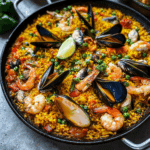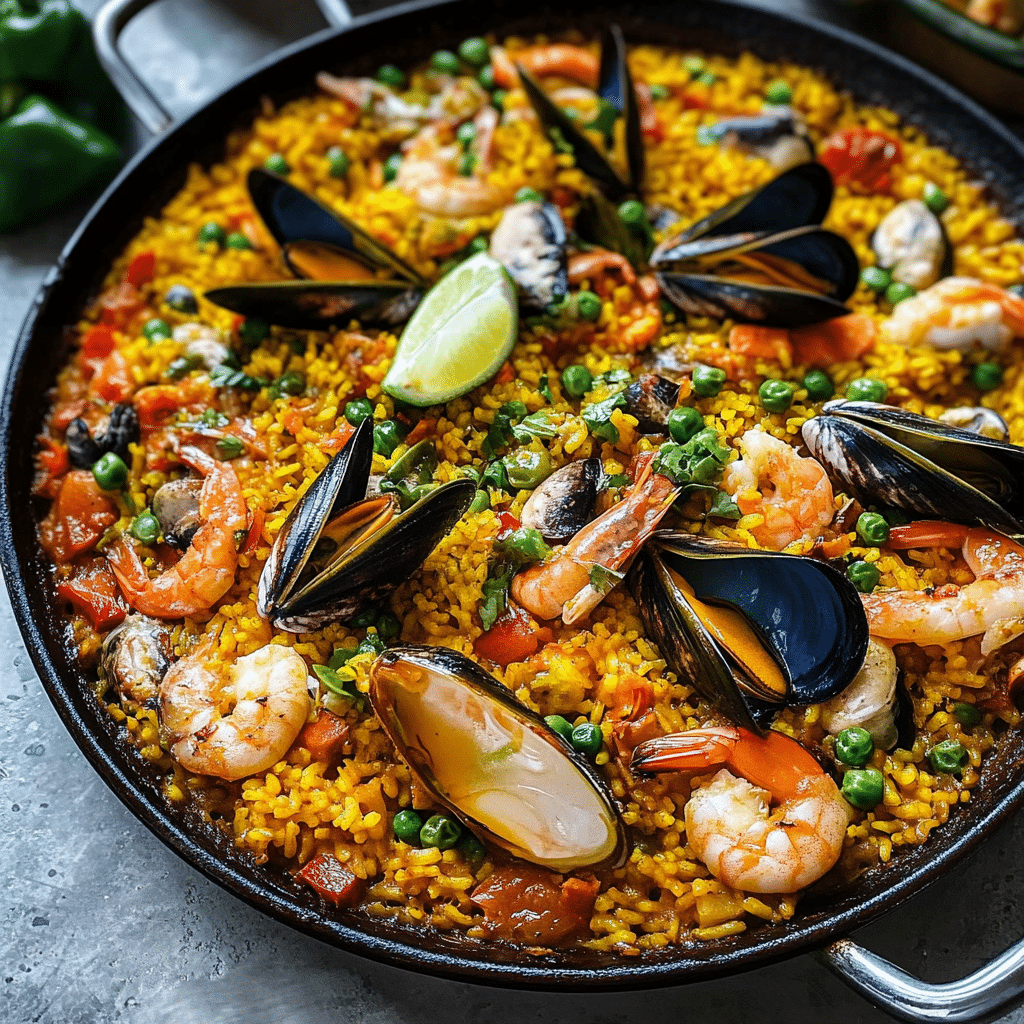If you’ve ever dreamed of bringing the rich, colorful flavors of Spain right into your kitchen, mastering Spanish Paella is the perfect place to start. This iconic dish blends vibrant saffron-infused rice, fresh seafood, tender meats, and a chorus of aromatic spices to deliver an experience that’s both comforting and festive. Whether you want to impress your friends or savor the taste of Valencia at home, discovering authentic Spanish Paella recipes and expert tips will guide you in creating a flavorful, traditional dish that feels like a celebration on every plate.
Why You’ll Love This Recipe
- Authentic flavors: Every bite captures the essence of traditional Spanish cuisine with genuine ingredients and spices.
- One-pan wonder: It’s a visually stunning, all-in-one meal that’s surprisingly easy to prepare and clean up after.
- Flexible and customizable: You can mix and match proteins, veggies, and spices to suit your taste or dietary needs.
- Perfect for gatherings: Spanish Paella brings family and friends together with its communal, shareable nature.
- Impressive presentation: It looks vibrant and gourmet, making it a fantastic centerpiece for dinner parties or celebrations.
Ingredients You’ll Need
The magic of Spanish Paella lies in simple, fresh ingredients that build complex layers of flavor, texture, and color. Each one plays a key role from the earthiness of saffron to the juicy bursts of seafood and vibrant vegetables.
- Short-grain rice: Use bomba or arborio rice for the signature tender yet firm texture that soaks up flavor without getting mushy.
- Saffron threads: These precious threads give the dish its golden color and subtle aromatic depth.
- Olive oil: A good extra virgin variety adds richness and brings out the flavors of other ingredients.
- Seafood mix: Mussels, shrimp, clams, or squid are classic choices for that coastal touch.
- Chicken and/or rabbit: Traditional protein options, adding hearty texture and flavor.
- Smoked paprika: Adds warmth and a slightly smoky nuance that defines this dish.
- Fresh garlic and onions: The aromatic base for building layers of flavor.
- Tomatoes: Provide acidity and balance, often used in sofrito (the cooking base).
- Bell peppers and peas: Add pops of color and sweetness for visual and flavor contrast.
- Chicken or fish broth: Essential for cooking the rice and infusing rich taste.
Variations for Spanish Paella
One of the best things about Spanish Paella is how easy it is to adapt based on your pantry, preferences, or dietary needs. Here are some creative twists to inspire your version.
- Vegetarian paella: Swap proteins for artichokes, roasted peppers, chickpeas, and a medley of seasonal vegetables.
- Seafood-only: Focus exclusively on shellfish and fish to celebrate coastal flavors.
- Meat lovers’ paella: Incorporate chorizo, rabbit, and chicken for a hearty, savory meal.
- Spicy version: Add smoked chili or cayenne powder for a subtle heat kick.
- Gluten-free adaptation: Naturally gluten-free, just ensure your broth and spices are free from additives.
How to Make Spanish Paella
Step 1: Prepare Your Ingredients
Start by chopping onions, garlic, tomatoes, and bell peppers while cleaning and prepping seafood and meats. Measure out rice, broth, and spices to keep everything within easy reach.
Step 2: Sauté the Sofrito
Heat olive oil in a wide, shallow paella pan or large skillet over medium heat. Add onions, garlic, and bell peppers, cooking gently until soft and fragrant. Stir in tomatoes and cook down until the mixture becomes a thick, luscious base called sofrito.
Step 3: Brown the Proteins
Add chicken pieces and any other meats, searing until golden on all sides to lock in flavor. Then, incorporate seafood just before the rice has cooked halfway to avoid overcooking.
Step 4: Add Rice and Spices
Pour in the rice and stir to coat every grain with the sofrito and spices, including saffron and smoked paprika. This step ensures the rice absorbs maximum flavor during cooking.
Step 5: Pour in Broth and Simmer
Carefully add hot broth, distributing it evenly across the pan. Let the mixture simmer gently without stirring, allowing the rice to cook evenly and form the prized crust on the bottom known as socarrat.
Step 6: Add Vegetables and Seafood
Arrange peas, mussels, shrimp, and clams on top in a decorative pattern. Cover with a lid or foil if needed to help seafood steam perfectly while rice finishes cooking.
Step 7: Rest and Serve
Once the liquid is absorbed and seafood is cooked through, remove the pan from heat and let it rest for 5 to 10 minutes. This resting phase helps flavors meld beautifully before serving.
Pro Tips for Making Spanish Paella
- Use the right pan: A flat, wide paella pan spreads heat evenly to develop the signature crust.
- Don’t stir the rice: This prevents mushiness and helps create the crispy socarrat layer.
- Saffron infusion: Bloom saffron in a little warm broth before adding for maximum color and aroma.
- Fresh is best: Always use fresh seafood and quality broth for depth of flavor.
- Control heat carefully: Cooking slowly over medium to low heat ensures even rice cooking without burning.
- Rest before serving: Let the paella sit off the heat so flavors develop and the texture settles.
How to Serve Spanish Paella
Garnishes
A generous squeeze of fresh lemon adds brightness just before eating, while fresh parsley or chopped chives offer a pop of green and freshness on top.
Side Dishes
Spanish Paella shines on its own but pairs wonderfully with simple sides like a crisp green salad, crusty bread, or a light tomato and cucumber salad to balance its richness.
Creative Ways to Present
Serve directly from the pan at the table for an authentic, communal experience. For a modern twist, plate individual servings with neatly arranged garnishes to impress your guests visually.
Make Ahead and Storage
Storing Leftovers
Place cooled paella in an airtight container and refrigerate for up to 3 days. Separate seafood if possible to maintain texture.
Freezing
Though best fresh, paella can be frozen in portions without seafood for up to 2 months; thaw thoroughly before reheating.
Reheating
Warm leftovers gently on the stove with a splash of broth to revive moisture, covering the pan to prevent drying out. Avoid microwaving to maintain texture.
FAQs
What type of rice is best for Spanish Paella?
Short-grain rice like bomba or arborio is ideal because it absorbs liquid well and maintains a firm texture without getting mushy.
Can I make Spanish Paella vegetarian?
Absolutely! Simply omit meat and seafood and load up on colorful vegetables like artichokes, bell peppers, and peas for a delicious vegetarian version.
How important is saffron in the recipe?
Saffron is key for authentic flavor and the dish’s signature golden hue, but if unavailable, turmeric can be a mild substitute for color, though flavor will differ.
What is socarrat?
Socarrat is the crispy, caramelized rice at the bottom of the pan that forms during cooking and is highly prized for its flavor and texture.
Can I use a regular skillet instead of a paella pan?
Yes, a wide, flat skillet can work well; just ensure it’s large enough to spread the rice in a thin layer for even cooking.
Final Thoughts
Mastering Spanish Paella at home is a joyful journey into Spanish culinary tradition that rewards you with a vibrant, flavorful meal made to share and savor. With authentic ingredients, simple steps, and a touch of patience, you can create a stunning dish that brings a piece of Spain straight to your table. So grab your pan, gather your ingredients, and get ready to enjoy one of Spain’s most beloved creations — it’s a feast you and your loved ones will remember!
Related Posts
- Why Creamy Orecchiette Pasta with Sausage Satisfies Cravings
- Quick Linguine with Clam Sauce: Easy & Delicious
- Quick Cilantro Pesto Chicken Tenders Delight

Spanish Paella
- Total Time: 1 hour
- Yield: 6 servings 1x
- Diet: Gluten Free
Description
Spanish Paella is a vibrant and festive one-pan dish that brings the rich, authentic flavors of Spain into your kitchen. Featuring saffron-infused short-grain rice, fresh seafood, tender meats, and an aromatic blend of spices and vegetables, this traditional recipe is perfect for gatherings and adaptable to various dietary preferences. Enjoy a comforting yet impressive meal that captures the essence of Valencian cuisine with every flavorful bite.
Ingredients
Rice and Spices
- 2 cups short-grain rice (bomba or arborio)
- 1/2 teaspoon saffron threads
- 1 teaspoon smoked paprika
Proteins
- 1/2 lb chicken pieces (thighs or drumsticks)
- 1/2 lb rabbit (optional, cut into pieces)
- 1 lb seafood mix (mussels, shrimp, clams, squid)
Vegetables and Aromatics
- 1 medium onion, finely chopped
- 3 cloves garlic, minced
- 2 medium tomatoes, diced
- 1 bell pepper, diced
- 1/2 cup peas (fresh or frozen)
Liquids and Oils
- 4 cups chicken or fish broth (hot)
- 3 tablespoons extra virgin olive oil
Garnishes (optional)
- Fresh lemon wedges
- Fresh parsley or chopped chives
Instructions
- Prepare Your Ingredients: Chop onions, garlic, tomatoes, and bell peppers while cleaning and prepping seafood and meats. Measure out rice, broth, and spices to have everything ready.
- Sauté the Sofrito: Heat olive oil in a wide, shallow paella pan or large skillet over medium heat. Add onions, garlic, and bell peppers, cooking gently until soft and fragrant. Stir in tomatoes and cook down until thickened to form the sofrito base.
- Brown the Proteins: Add chicken pieces and rabbit (if using), searing them until golden on all sides to lock in flavor. Add seafood later in the cooking process to prevent overcooking.
- Add Rice and Spices: Pour in the rice and stir to coat every grain with the sofrito mixture, saffron (bloomed in a little warm broth), and smoked paprika, ensuring maximum flavor absorption.
- Pour in Broth and Simmer: Add hot broth evenly across the pan. Let it simmer gently without stirring to allow even cooking and formation of the prized socarrat crust on the bottom.
- Add Vegetables and Seafood: Arrange peas, mussels, shrimp, and clams on top decoratively. Cover with a lid or foil if needed to help the seafood steam while the rice finishes cooking.
- Rest and Serve: After all liquid is absorbed and seafood is cooked through, remove from heat and let the paella rest for 5 to 10 minutes. This allows the flavors to meld and the texture to set before serving.
Notes
- Use a wide, flat paella pan for even heat distribution to develop the socarrat crust.
- Do not stir the rice once broth is added to prevent mushiness and encourage caramelization.
- Bloom saffron in warm broth before adding to enhance color and aroma.
- Use fresh seafood and quality broth for authentic and rich flavors.
- Control heat carefully to cook slowly over medium to low to avoid burning.
- Allow the paella to rest off heat before serving to improve taste and texture.
- Leftovers can be refrigerated up to 3 days; separate seafood if possible to maintain texture.
- Paella without seafood can be frozen for up to 2 months; thaw thoroughly before reheating gently on the stove with broth.
- Avoid using a microwave to reheat to preserve texture and flavor.
- Prep Time: 20 minutes
- Cook Time: 40 minutes
- Category: Main Course
- Method: Stovetop
- Cuisine: Spanish
Nutrition
- Serving Size: 1 serving (approximately 1/6 of recipe)
- Calories: 450 kcal
- Sugar: 4 g
- Sodium: 700 mg
- Fat: 15 g
- Saturated Fat: 3 g
- Unsaturated Fat: 10 g
- Trans Fat: 0 g
- Carbohydrates: 50 g
- Fiber: 3 g
- Protein: 30 g
- Cholesterol: 85 mg


